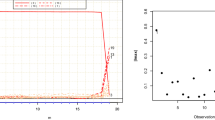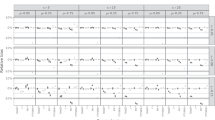Abstract
Purpose. Data from single individuals, or a small group of subjects may influence non-linear mixed effects model selection. Diagnostics routinely applied in model building may identify such individuals, but these methods are not specifically designed for that purpose and are, therefore, not optimal. We describe two likelihood-based diagnostics for identifying individuals that can influence the choice between two competing models.
Methods. One method is based on a jackknife of the raw data on the individual level and refitting the model to each new data set. The second method is a calculation which utilises the contribution each individual make to the objective function values under each of the two models. The two methods were applied to model selection during analysis of a real data set.
Results. The agreement between the methods was high. Individuals for whom there was a discrepancy between the methods tended to be those for which neither of the contending models described the data appropriately. Both methods identified individuals that influenced the model selection.
Conclusions. Two objective, specific and quantitative methods for identifying influential individuals in nonlinear mixed effects model selection have been presented. One of the methods doesn't require additional model fitting and is therefore particularly attractive.
Similar content being viewed by others
REFERENCES
P. O. Maitre, M. Buhrer, D. Thomson, and D. R. Stanski. A three-step approach combining Bayesian regression and NONMEM population analysis: application to midazolam. J. Pharmacokinet. Biopharm. 19:377-384 (1991).
S. L. Beal and L. B. Sheiner (Eds) NONMEM Users Guides. NONMEM Project Group, University of California at San Francisco, San Francisco, 1998.
J. W. Mandema, D. Verotta, and L. B. Sheiner. Building population pharmacokinetic-pharmacodynamic models. I. Models for covariate effects. J. Pharmacokin. Biopharm. 20:511-528 (1992).
E. N. Jonsson and M. O. Karlsson. Automated covariate model building within NONMEM. Pharm. Res. 15:1463-8 (1998).
J. W. Mandema, D. Verotta, and L. B. Sheiner. Building population pharmacokinetic-pharmacodynamic models. In Advanced methods of pharmacokinetic and pharmacodynamic systems analysis. Volume 2. Ed. DZ D'Argenio, Plenum Press, New York, 1995.
E. I. Ette and T. M. Ludden. Population pharmacokinetic modeling: the importance of informative graphics. Pharm. Res. 12:1845-1855 (1995).
E. N. Jonsson and M. O. Karlsson. Xpose-An SPLUS based population pharmacokinetic-pharmacodynamic model building aid for NONMEM. Comput. Methods Programs Biomed. 58:51-64 (1999).
B. Efron and R. J. Tibshirani. An introduction to the bootstrap. Chapman & Hall, New York, 1993.
M. O. Karlsson, E. N. Jonsson, C. G. Wiltse, and J. R. Wade. Assumption testing in population pharmacokinetic models: illustrated with an analysis of moxonidine data from congestive heart failure patients. J. Pharmacokin. Biopharm. 26:207-46 (1998).
D. W. Cockroft and M. H. Gault. Prediction of creatinine clearance from serum creatinine. Nephron 16:31-41 (1976).
J. Wakefield (discussant). In J. S. Hodges. Some algebra and geometry for hierarchical models, applied to diagnostics. J. R. Statist. Soc. B 60:497-536 (1998).
Author information
Authors and Affiliations
Corresponding author
Rights and permissions
About this article
Cite this article
Sadray, S., Jonsson, E.N. & Karlsson, M.O. Likelihood-Based Diagnostics for Influential Individuals in Non-Linear Mixed Effects Model Selection. Pharm Res 16, 1260–1265 (1999). https://doi.org/10.1023/A:1014857832337
Issue Date:
DOI: https://doi.org/10.1023/A:1014857832337




